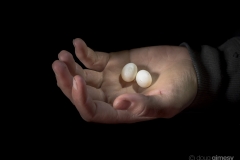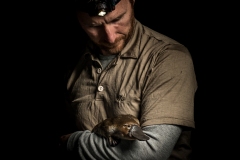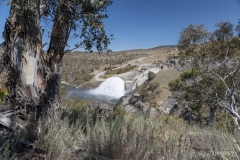Platypus on the EDGE
The platypus (Ornithorynchus anatinus) is a unique and iconic egg laying mammal that is the only living representative of its family and genus. Sadly it looks like it is moving towards becoming an EDGE species. What’s an EDGE species you ask? One that is Evolutionary Distinct and Global Endangered. In other words, a species that once it’s gone, its gone and there is no other species even remotely close left. Australia already has too many of these.
Once incredibly abundant along the east coast of Australia as well as in Tasmania, their conservation status was recently upgrade from ‘least concern’ to ‘vulnerable‘. Over the last 30 years their available habitat has shrunk by over 20%, or about 200,000 square kms – that’s an area nearly three times the size of Tasmania. Recently listed as vulnerable to extinction in Victoria, some scientists now believe that they could be nationally threatened.
Threats
Human driven threats include:
– Creating large river impoundments that are too deep for platypus to feed.
– Climate change
– Habitat destruction from urban and rural development
– Reduced river flows as a result of drought, increased residential and commercial water withdrawal and the creation of dams
– Forestry and agricultural practices that impact bank erosion, bed destabilisation and increase sedimentation
– So called ‘River improvements’ that impact the suitability of streams and rivers for platypus
– Sudden increases in river flows as a result of flash floods, dam releases, and urban storm water run off
– Drowning from entanglement in recreational enclosed yabby traps (such as in opera house nets) and fishing lines
– Trauma from fishing lines, fishing hooks, and other plastic pollution like girls hair ties and rubber bands (in which they get their heads caught in)
– Predation due to shallow water and lack of cover on banks
– Chemical and biological river pollution
– Localised extinction events which isolate populations and so fracturing genetic diversity
Interesting facts
– Early European biologists originally thought they were a fake animal
– Some aboriginal names for the platypus include Matakupay, Mallangong, Tambreet, Gaya-dari, Boondaburra, Lare-re-lar
– Some Aboriginal dreamtime stories explain that the platypus came about from the mating of a large water rat with a duck.
– Discoveries in platypus milk could help fight superbugs (news link here)
– Platypuses avoid streams in logged areas
– Platypus young drink their mothers milk by licking it off their skin
– Platypuses can visit several burrows in one night
– Platypuses dive limit is around 2-3 minutes
– Australia once sent a platypus to Wintson Churchill, however it died before getting there (link here)
– Platypuses lay eggs, have very small stomachs and adults have no teeth. The adults grind their food with hard pads (made from keratin) that replace the teeth
– Male platypuses have a bifurcated penis
– Male platypuses have venomous spurs on their back ankles and so are one of the few venomous mammals in the world.
– Platypuses have 10 sex chromosomes (5 pairs) – most mammals typically have just two (i.e. a single pair)
– The platypus is the only living representative of its family and genus
– Their family is older than dinosaurs and with the first fossil platypus relatives (Monotrematum sudamericanum) date back 61 millions years from Patagonia – showing how widespread they used to be (link here) and a one meter long relative (Obdurodon tharalkooschild) swam through freshwater pools in Australian forests about 5 to 15 million years ago
– Some Aboriginal dreamtime stories explain that the platypus resulting from the mating of a large water rat with a duck
– Platypuses swim underwater with their eyes closed and ‘see’ using electrical receptors in their bills to find their prey and pressure sensors to aid in navigation – a kind of sixth sense!
– As one of the top predators in many Australian waterways, platypuses help maintain ecosystem balance and water health
What am I doing?
Awareness and education:
My hope is that in further raising awareness of the human made issues we are creating for this little monotreme, that maybe we (i.e. Australians) will act before it is to late. We can’t allow the platypus to move from being ‘near threatened’ to being ‘vulnerable’ to extinction. We just can’t.
To help raise awareness, over the last few years I have had a pieces published by National Geographic, Australian Geographic, BBC wildlife, Biographic, and The Big Issue, as well a piece specifically on the dangers of enclosed yabby traps (link here). I will continue to work on expanding my platypus gallery and get further stories published.
Most recently, I have facilitated a grant from AWS to produce promotional materials (examples below) and arrange for platypus expert Josh Griffiths (from platypusSPOT) to run a series of Victorian regional school based education sessions to engage children and the community about the platypus, and what they can do to help ensure it survives and thrives. These talks will run over late 2019 and 2010.
Government protection:
In mid 2018 I submitted an application to the Victorian Government suggesting the platypus be listed as threatened under the Flora and Fauna Guarantee Act. In 2021 they were listed as vulnerable to extinction, giving them and their habitats greater protection.
I also chaired the Victoria Alliance for Platypus-Safe Yabby Traps, and am pleased to say, in 2019, we managed to get the platypus drowning enclosed yabby trap banned in Victoria.
What can you do?
If you live in Australia, there are lots of things you can do to help. For example:
1) Use less water – even at home – it allows more to be released from dams into their home environment
2) Help keep our rivers clean and healthy. For example, pick up any plastic rings you find (e.g. hair ties, rubber bands) as platypus can get their heads caught in these
3) Fish responsibly
Also, if you sometimes visit places where you may see a platypus, please download the app ‘PlatypusSPOT’, and report any sightings. As a citizen science initiative, then more information we have about this elusive mammal, the better position we will be to help conserve and protect them.






















